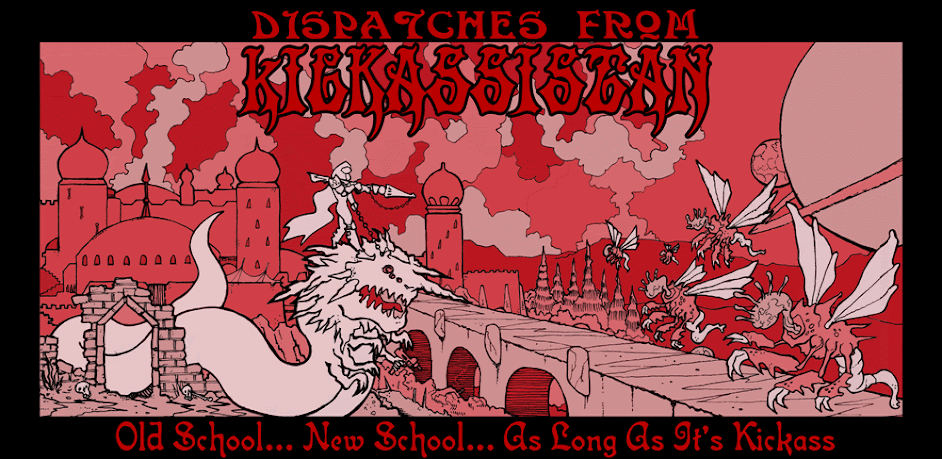In general, The Complete Warlock and its predecessor Warlock rules were both written to clarify and expand on OD&D. Up until now, we've been dealing with rules expansions like the spell point mechanism for Magic Users and the 0th-level spells that Clerics get. Today, I'll be looking at the key place where Warlock is written to clarify OD&D rules -- namely, combat. Whether Warlock accomplishes the mission it sets out to do, however, I'll believe is a matter of some debate.
One of the things that draws me back to LBB OD&D (Whitebox OD&D, whatever you want to call it) is the simplicity of the dice. One of my favorite details of TCW is that it keeps the same d6 & d20 scheme that Whitebox has. Folks out there will know that I'm a big fan of the wide variety of standard polyhedrals and even the funky dice out there, but when I play an OD&D game, I want things to be as simple as I can get them, which means that d20/d6 is the way to go for me (if I could get away with just d6s, I would). I'm not sure why, but when I look at advancement tables and I see hit dice listed as "1," "1+1" and such without any attempt made to explain what sort of dice are being rolled, I get this reassured, calm feeling that we're gaming in a universe where the rules work toward greater and greater parity between the character classes. When your average dagger (because it's d6 for damage just like everything else) can kill pretty much anyone in the party (or at least stands a solid chance of killing anyone in the party), everyone needs to be extra cautious.
OD&D - and the CHAINMAIL that it's based on - only varied weapons by their likelihood to hit opponents in different sorts of armor (although if you were using the d20-based "alternative" system presented in the LBBS, you'd have to wait for Greyhawk for that effect). The earliest versions of Warlock probably didn't wait for Greyhawk for that bit of logic and probably modeled their system off of CHAINMAIL instead of the d20 system. TCW strips out the CHAINMAIL d6-based system and moves the probability distribution to a percentage (remember that percentile dice logic was not common when OD&D was first written and not all the immediately-post-D&D systems like RQ, Chivalry & Sorcery and so on all use percentile dice).
I understand how, back in 1975, percentile dice seem like an exciting new dice mechanism, how the ease of comparing likelihoods is facilitated by switching to a straight percentile system made doing so remarkably attractive. How, compared with the belled distribution of multiple d6s where target numbers lie somewhere along a curve with varying degrees of likelihood, or even the 5%-per-face distribution of the d20, the "what you see is what you get" simplicity of the percentile dice seems like a good idea. And so, I can't blame TCW for using percentile dice. The Attack Matrix table also includes a "Dice DMG" column, with listings from "1/2" to "4," rather than using a Greyhawk-style variation in damage die type.
The one thing the Attack Matrix doesn't do is account for a difference in levels. Here, TCW uses a fairly strange formula: it is assumed that two combatants engaged in melee are of the same level. Whatever difference in level, multiply it by 3 and add it to the higher-level character's probability to hit. Okay, maybe it's not that complex, but it's definitely weird. Percentiles that change only when there's a difference and only by the amount of the difference. Hmm. It's okay, but not anything I'd choose to play.
Dice
 |
| Not actually a d12, but hey, why not? |
Melee Combat
I'm going to out myself as an OD&D newb right now and say I still have no idea what it means when someone attacks as a "Man," as "2 Men," or as a "Hero," or even "Superhero." I just can't figure it out. Yeah, I know I'm supposed to able to read CHAINMAIL and sort it all out, but I just don't get it. Thankfully, Uncle Gary also included an extra chart that uses a d20 to sort out combat so we're not completely lost. Well, looking at the advancement tables included in the LBBs, I'm not surprised that the CalTech team needed something else to base their combat system off of.OD&D - and the CHAINMAIL that it's based on - only varied weapons by their likelihood to hit opponents in different sorts of armor (although if you were using the d20-based "alternative" system presented in the LBBS, you'd have to wait for Greyhawk for that effect). The earliest versions of Warlock probably didn't wait for Greyhawk for that bit of logic and probably modeled their system off of CHAINMAIL instead of the d20 system. TCW strips out the CHAINMAIL d6-based system and moves the probability distribution to a percentage (remember that percentile dice logic was not common when OD&D was first written and not all the immediately-post-D&D systems like RQ, Chivalry & Sorcery and so on all use percentile dice).
I understand how, back in 1975, percentile dice seem like an exciting new dice mechanism, how the ease of comparing likelihoods is facilitated by switching to a straight percentile system made doing so remarkably attractive. How, compared with the belled distribution of multiple d6s where target numbers lie somewhere along a curve with varying degrees of likelihood, or even the 5%-per-face distribution of the d20, the "what you see is what you get" simplicity of the percentile dice seems like a good idea. And so, I can't blame TCW for using percentile dice. The Attack Matrix table also includes a "Dice DMG" column, with listings from "1/2" to "4," rather than using a Greyhawk-style variation in damage die type.
The one thing the Attack Matrix doesn't do is account for a difference in levels. Here, TCW uses a fairly strange formula: it is assumed that two combatants engaged in melee are of the same level. Whatever difference in level, multiply it by 3 and add it to the higher-level character's probability to hit. Okay, maybe it's not that complex, but it's definitely weird. Percentiles that change only when there's a difference and only by the amount of the difference. Hmm. It's okay, but not anything I'd choose to play.
The Combat Turn
One of the common gripes about OD&D is that it uses several terms such as "turn" and "round" interchangeably, often in mutually exclusive ways. TCW tries to fix this with a single, unified time measurement, wherein a "turn" is exactly one minute, but is comprised of six "phases," each ten seconds long. Does this sound like any other round structure you might have encountered? Well, unlike the Greyhawk/1e system, TCW's combat phases are more like rounds, each consisting of three separate parts: Movement, Magic & Archery and Melee. Within each part of a phase, actions are taken in descending Dexterity order which follows the Men & Magic description of what Dexterity does and the later Holmes revision.
One of the weird things here is the concepts of the Dexterity Count, wherein each "tick"down from the highest Dex score to the lowest in each part of a phase, and that many things happen over time across Dexterity Counts such as spell casting and missile fire. Thus, if an arrow is fired on a particular Dex Count, it won't hit its target until several Dex Counts later, and keeps travelling until it hits its mark or ... well, or it hits nothing. If the target isn't there anymore, it can't quite hit him, right?
So, that's the beginning of the Day Five investigation of combat in TCW. Next time, we'll look at missile fire (or "Archery" as TCW calls all forms of ranged combat) and a bit of analysis & commentary on how this all breaks down. See you then!


Comments
Post a Comment